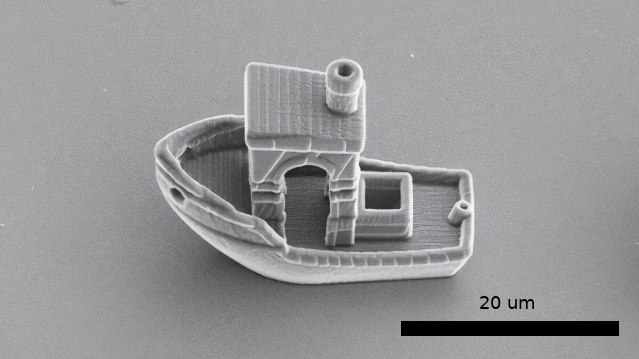We’ve said it before, but we cast a wary eye at any superlative claims that come our way. “World’s fastest” or “world’s first” claims always seem to be quickly debunked, but when the claim of “World’s Smallest Benchy” is backed up by a tugboat that two dozen E. coli would have a hard time finding space on, we’re pretty comfortable with it.
Of course the diminutive benchmark was not printed just for the sake of it, but rather as part of a demonstration of what’s possible with “microswimmers”, synthetic particles which are designed to move about freely in microscopic regimes. As described in a paper by [Rachel P. Doherty] et al from the Soft Matter Physics lab at Leiden University, microswimmers with sizes on the order of 10 to 20 μm can be constructed repeatably, and can include a small area of platinum catalyst. The catalyst is the engine of the microswimmer; hydrogen peroxide in the environment decomposes on the catalyst surface and provides a propulsive force.
Artificial microswimmers have been around for a while, but most are made with chemical or evaporative methods which result in simple shapes like rods and spheres. The current work describes much more complex shapes — the Benchy was a bit of a flex, since the more useful microswimmers were simple helices, which essentially screw themselves into the surrounding fluid. The printing method was based on two-photon polymerization (2PP), a non-linear optical process that polymerizes a resin when two photons are simultaneously absorbed.
The idea that a powered machine so small could be designed and manufactured is pretty cool. We’d love to see how control mechanisms could be added to the prints — microfluidics, perhaps?
















Neato! This reminded me of a lecture and paper from 1976 and looking at it, it is very conversational and fits the topic. ‘Life at Low Reynolds Number’ and it is about the movement and behavior of things the size of this Benchy in water. If you read it and are younger than a boomer, a dyne is a unit of force defines as 1 gram-centimeter/sec/sec or 10 micro-newtons and an A with a circle over it is an angstrom, a unit of length from optics. 10 angstroms to a nano-meter.
https://science.curie.fr/wp-content/uploads/2016/04/Purcell_life_at_low_reynolds_number_1977.pdf
I recommend an ether bath to smooth out those layer lines. Also, there appears to be some trouble with your z-axis. Maybe change out the threaded rod for something better. ;)
When this story was actually new (HaD is often far behind on 3DP), I think all of those were mentioned.
This is no older than 2 weeks? far behind?
Also, if you don’t mind, where did you see it first?
This is clearly very old because the picture is in black and white.
+1
[b3] [o4]
I got microswimmers as well. I so wanted to have family.
PLA or ABS ?
;-)
we need duplicator
Looks like a neat improvement on the technology that we had at the Uni
https://www.sussex.ac.uk/iisp/projects/fabrication
It’s cool, but have you seen that Femtica went a step further and created the so-called “Nano Jesus”? That’s just pro level!
STL please :)